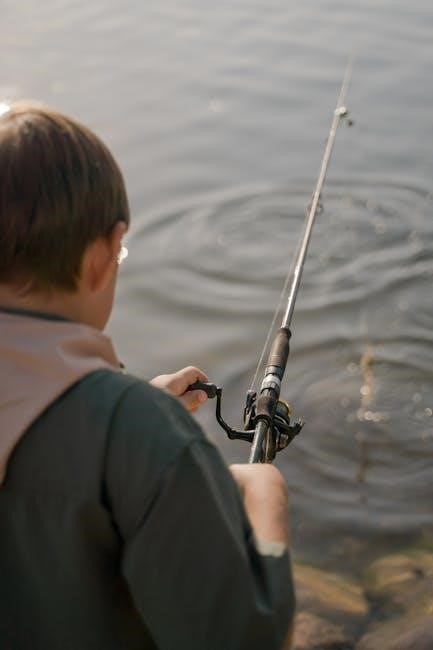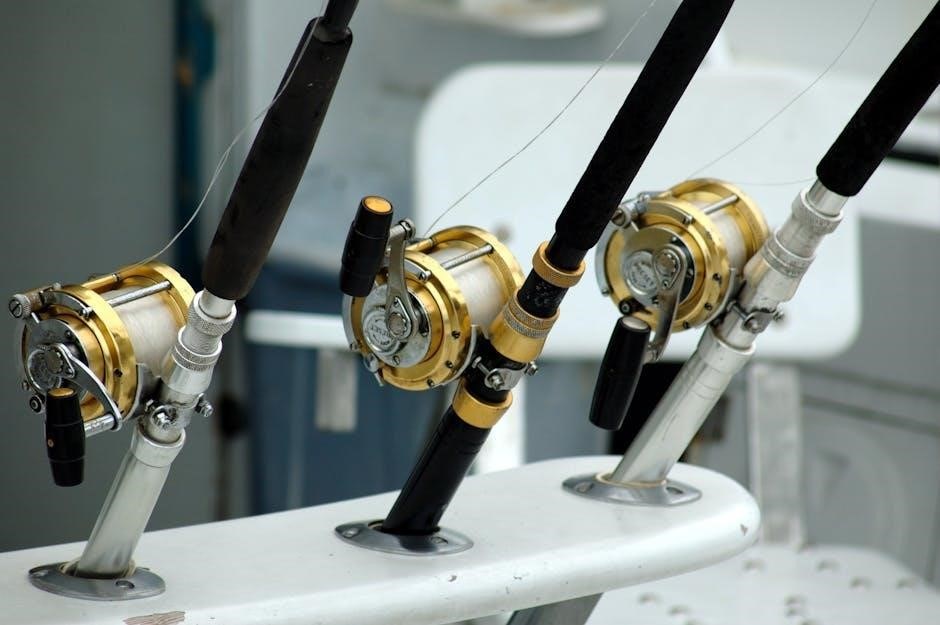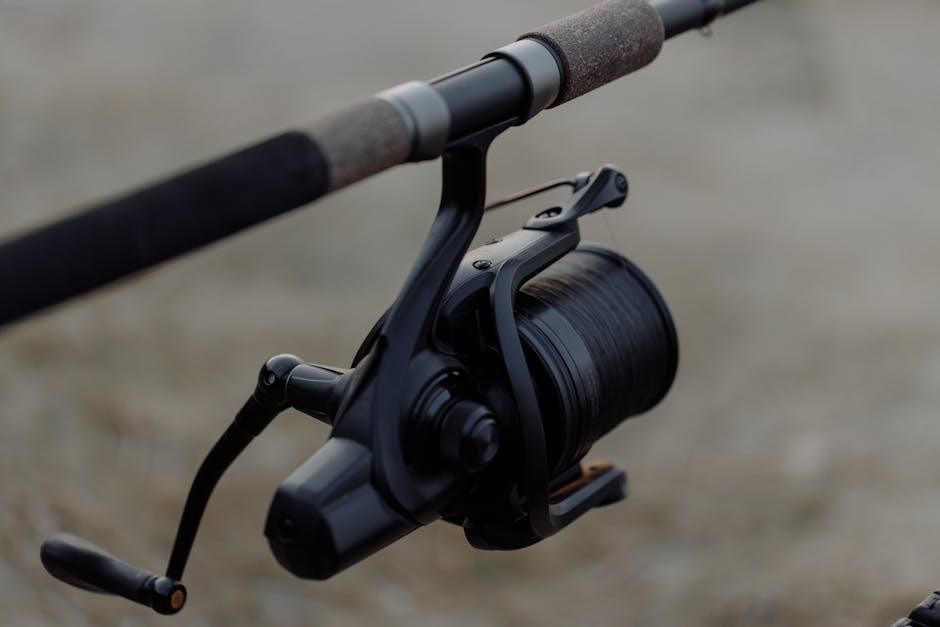A fishing rod guide is a crucial component that helps direct the line along the rod, ensuring smooth casting and retrieval. Properly aligned guides enhance accuracy and performance.
What is a Fishing Rod Guide?
A fishing rod guide is a small circular or oval ring attached along the length of a fishing rod. These guides are typically made from durable materials like ceramic, stainless steel, or titanium, ensuring longevity and smooth line flow. They are strategically placed to help manage the fishing line, distributing stress evenly and preventing tangles or abrasion. Guides come in different sizes, with larger ones near the reel and smaller ones toward the tip. They are essential for maintaining line control during casting and retrieval, and their placement and quality significantly impact the rod’s performance; Properly functioning guides ensure a smoother angling experience.
Importance of Fishing Rod Guides in Angling
Importance of Fishing Rod Guides in Angling
Fishing rod guides are vital for ensuring smooth line flow and consistent performance during angling. They minimize friction, preventing line wear and tangles, while enhancing casting accuracy and distance. Properly functioning guides also distribute stress evenly, reducing the risk of line breakage during fights with larger fish. Additionally, they play a key role in controlling the fish once hooked, allowing for better maneuverability. High-quality guides are essential for durability, especially in harsh fishing conditions. Their strategic placement and material quality directly impact the overall fishing experience, making them indispensable for both novice and experienced anglers seeking optimal results.
Components of a Fishing Rod
A fishing rod consists of a blank, reel seat, and guides. The blank forms the rod’s structure, while the reel seat secures the reel. Guides direct the line, ensuring smooth casting and retrieval.
Key Parts of a Fishing Rod
A fishing rod is made up of several essential components, each serving a specific purpose. The blank is the main shaft of the rod, providing flexibility and strength. The reel seat is where the reel is attached, ensuring it stays securely in place during use. Guides are circular rings along the rod that direct the fishing line, preventing tangles and improving casting accuracy. The tip is the sensitive end of the rod, detecting even the slightest bites. Finally, the handle offers a comfortable grip, allowing for better control and leverage when fighting fish.
Role of Guides in Rod Performance
Fishing rod guides play a vital role in enhancing the overall performance of the rod. They are designed to reduce line friction, allowing for smoother casting and retrieval. Guides also improve sensitivity by enabling the rod to flex more naturally, helping anglers detect even the slightest bites. Properly aligned guides ensure consistent line flow, which is crucial for accurate casting and controlling the fish during a fight. Additionally, they help distribute pressure evenly along the rod, reducing the risk of line breakage and improving overall durability. Well-functioning guides are essential for maximizing both casting distance and control, making them a critical component for successful angling.

Choosing the Right Fishing Rod
Choosing the right fishing rod involves considering your fishing purpose, technique, and target species. Factors like action, power, and length ensure the rod matches your skill level perfectly.
How to Select the Best Rod for Your Needs
Selecting the best fishing rod for your needs involves understanding your target species, fishing technique, and the environment. Consider the rod’s action (slow, medium, or fast) and power (light, medium, or heavy) to match your fishing style. The rod’s length and material (graphite, fiberglass, or composite) also play a crucial role. Graphite rods are sensitive and lightweight, while fiberglass rods are durable and ideal for beginners. Ensure the rod is balanced with your reel and line for optimal performance. Lastly, consider personal preference and comfort to enhance your fishing experience.
Understanding Rod Action and Power
Rod action refers to how much the rod bends during use, while power indicates its strength and ability to handle fish. Slow-action rods bend more and are ideal for smaller species, offering a more forgiving experience. Medium-action rods provide a balance, making them versatile for various fishing conditions. Fast-action rods bend less and deliver quick hook sets, suitable for larger fish and precise techniques. Power levels range from light to heavy, determining the size of fish the rod can handle. Matching the rod’s action and power to your fishing style and target species ensures optimal performance and a more enjoyable angling experience.

Maintenance and Care
Regular cleaning prevents damage and ensures smooth performance. Proper storage in a dry place extends the rod’s life and maintains its effectiveness. Protecting the guides and components from corrosion is essential for longevity.
How to Clean and Maintain Your Fishing Rod
Regularly cleaning your fishing rod is essential to ensure its longevity and performance. Start by wiping down the rod with a soft, dry cloth to remove dirt and grime. For tougher stains, use a mild soap solution and a microfiber cloth, paying special attention to the guides and ferrules. Avoid harsh chemicals or abrasive materials that could damage the finish or components. After cleaning, dry the rod thoroughly to prevent moisture buildup. Inspect the guides and ferrules for any signs of wear or damage and address them promptly to maintain smooth line flow.
Store your rod in a cool, dry place, away from direct sunlight. Use a protective rod case or sleeve to prevent scratches and dings. Regular maintenance ensures your rod remains in optimal condition for future fishing trips. By following these simple steps, you can extend the life of your fishing rod and keep it performing at its best.
Proper Storage to Extend Rod Life
Storing your fishing rod correctly is vital to maintain its condition and longevity. Always keep it in a cool, dry place away from direct sunlight to prevent damage from UV rays. Use a high-quality rod case or sleeve to protect against scratches and impacts. Avoid storing the rod in tight or bent positions, as this can cause permanent warping. If the rod is sectioned, ensure each piece is securely stored to prevent misalignment. Moisture can lead to rust or corrosion, so thoroughly dry the rod before storage. Proper care during storage ensures your fishing rod remains in excellent shape for future use.
Setting Up Your Fishing Rod

Start by attaching the reel securely to the rod’s reel seat. Next, thread the fishing line through each guide, ensuring it flows smoothly without tangles or twists.

Threading the Line Through Guides
Threading the line through your fishing rod guides is a simple yet critical process. Start by attaching the reel to the rod and holding it horizontally. Gently pull a small amount of line from the reel and thread it through the first guide nearest to the reel. Continue this process, guiding the line through each subsequent guide along the rod. Ensure the line flows smoothly without twists or tangles. Once all guides are threaded, give the line a light tug to check for any obstructions. Proper threading ensures smooth casting, accurate presentations, and better control during retrieval.
Attaching the Reel to the Rod

Attaching the reel to the rod is a straightforward process that ensures proper functionality. Locate the reel seat at the base of the rod handle. Align the reel’s mounting hoods with the seat. Gently slide the reel onto the seat, ensuring it fits securely. Tighten the reel seat hood or nut by hand, then use a wrench for a snug fit. Avoid overtightening to prevent damage. Once secured, check the reel’s alignment and movement. A properly attached reel ensures smooth line flow and optimal performance. Always double-check the connection before fishing to avoid any issues on the water.

Common Mistakes to Avoid
Ignoring guide alignment can lead to line tangles and poor casting performance. Using excessive force when threading the line through guides can damage the rod or guides.
Improper Use of Guides
One of the most common mistakes anglers make is failing to ensure guides are properly aligned. Misaligned guides can cause line tangles, reduce casting accuracy, and even damage the rod. Additionally, forcing the fishing line through the guides instead of threading it gently can lead to fraying or breakage. Neglecting to clean and maintain guides regularly can also hinder performance, as dirt and debris can build up and disrupt line flow. Overlooking these issues can significantly impair the overall efficiency of the fishing rod and the angling experience. Proper care and attention to guides are essential for optimal performance.
Overloading the Rod
Overloading a fishing rod occurs when excessive force or weight is applied, often due to using a line that’s too heavy or fighting a fish beyond the rod’s capacity. This can cause permanent damage, such as warping or cracking the blank. Fast action rods, commonly used for lure fishing, are particularly susceptible to overloading if not handled carefully. Properly matching the line weight to the rod’s specifications is crucial to prevent this issue. Additionally, angler technique plays a significant role; applying too much pressure during a fight can strain the rod beyond its limits.

Frequently Asked Questions
Frequent questions include inquiries about the materials used for guides and tips on selecting the appropriate rod length for specific fishing conditions and species.
What Material are Guides Made Of?
Fishing rod guides are typically made from durable materials such as ceramic, stainless steel, or titanium. Ceramic guides are known for their smoothness and ability to prevent line wear, while stainless steel offers strength and corrosion resistance. Titanium guides are lightweight and highly resistant to corrosion, making them ideal for saltwater fishing. High-quality rods often feature hard, wear-resistant materials to ensure longevity and performance. The choice of material depends on the type of fishing and the conditions in which the rod will be used, ensuring optimal durability and functionality.

How to Choose the Right Rod Length
Choosing the right rod length depends on the type of fishing and the environment. Shorter rods (5-6 feet) are ideal for accuracy in tight spaces, such as small streams or ice fishing. Medium rods (7-8 feet) are versatile and suit most freshwater and light saltwater fishing. Longer rods (9 feet or more) are best for surf fishing, fly fishing, or casting long distances. Consider the species of fish and the casting distance needed. A 7-foot rod is often recommended for general-purpose fishing, balancing ease of use and performance. Always match the rod length to your specific fishing needs for optimal results.
Maximizing your fishing experience starts with understanding and maintaining your gear. A quality rod with proper guides ensures smooth casting and line protection. Happy fishing!
Final Tips for Maximizing Your Fishing Experience
Regularly inspect and maintain your rod guides to ensure optimal performance. Choose guides that match your fishing style and environment for durability. Always thread the line carefully to avoid tangles. Consider the action and power of your rod when selecting lures or bait. Store your rod properly to prevent damage. Experiment with different techniques to enhance your casting accuracy. Invest in high-quality lines and reels to complement your rod setup. By combining proper maintenance, understanding your gear, and adapting to conditions, you can elevate your fishing experience and catch more fish successfully.

No Responses